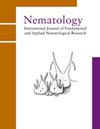Pathogenicity and boarding ability of hybrid-derived populations between Bursaphelenchus xylophilus and B. mucronatus (Nematoda: Aphelenchoididae)
IF 1.1
4区 生物学
Q2 ZOOLOGY
引用次数: 0
Abstract
Summary The pine wood nematode, Bursaphelenchus xylophilus (Steiner et Buhrer), is the causative agent of pine wilt disease. It is native to North America and has been devastating pine forests in East Asia and West Europe since its introduction. The pathogenic nematode is transmitted by cerambycid beetle adults of Monochamus alternatus Hope in East Asia and M. galloprovincialis (Olivier) in West Europe. Bursaphelenchus mucronatus Mamiya et Enda is widely distributed in Eurasia and has no or little pathogenicity to pine species. If hybrids between the two species are backcrossed with B. xylophilus nematodes repeatedly, a small proportion of B. mucronatus genes will be infused into B. xylophilus genome (introgression) and may lead to adaptation to locally harsh environments. Inoculation tests in this study revealed that two of eight hybrid-derived populations from crossing B. xylophilus and B. mucronatus caused pine seedling mortalities of 36-70%. The pathogenic hybrid-derived populations carried nuclear ribosomal DNA (rDNA) of two species and B. xylophilus extra-nuclear genes, whereas non-pathogenic populations carried B. mucronatus rDNA and extranuclear genes of B. xylophilus or B. mucronatus . Thus, it is inferred that a gene or genes associated with pathogenicity are present in the nuclear genome of B. xylophilus . A laboratory experiment revealed that the pathogenic hybrid-derived population had as great an ability to board M. alternatus adults as the parental-lineage B. xylophilus isolate. Thus, the introgressive hybridisation is considered to occur in pine forests if two species cohabit in host trees.嗜木刺线虫与大刺线虫杂交群体的致病性及登岛能力
松材线虫(Bursaphelenchus xylophilus, Steiner et Buhrer)是松材枯萎病的病原。它原产于北美,自引进以来一直破坏东亚和西欧的松林。致病性线虫是由东亚的交替单chamus alternatus Hope的陶粒甲虫成虫和西欧的加洛省单跖虫(Olivier)传播的。巨松病菌(Bursaphelenchus mucronatus Mamiya et Enda)广泛分布于欧亚大陆,对松树没有或只有很小的致病性。如果两种杂交种与嗜木线虫反复回交,一小部分嗜木线虫基因会被注入到嗜木线虫基因组中(渗入),并可能导致其适应当地恶劣的环境。本研究的接种试验结果表明,在8个由木嗜木霉与巨巨木霉杂交而成的群体中,有2个群体的幼苗死亡率为36 ~ 70%。致病性杂交种群体携带两种病原菌的核糖体DNA (rDNA)和木褐螺旋藻的核外基因,而非致病性杂交种群体携带木褐螺旋藻或木褐螺旋藻的rDNA和核外基因。因此,我们推断,与致病性相关的一个或多个基因存在于嗜木杆菌的核基因组中。室内实验结果表明,该致病杂交种种群与亲本系嗜木耳白僵菌分离株具有同样强的寄主能力。因此,如果两个物种在寄主树上同居,则可以认为在松林中发生了渐渗杂交。
本文章由计算机程序翻译,如有差异,请以英文原文为准。
求助全文
约1分钟内获得全文
求助全文
来源期刊

Nematology
生物-动物学
CiteScore
2.60
自引率
33.30%
发文量
67
审稿时长
3 months
期刊介绍:
Nematology is an international journal for the publication of all aspects of nematological research (with the exception of vertebrate parasitology), from molecular biology to field studies. Papers on nematode parasites of arthropods, and on soil free-living nematodes, and on interactions of these and other organisms, are particularly welcome. Research on fresh water and marine nematodes is also considered when the observations are of more general interest.
Nematology publishes full research papers, short communications, Forum articles (which permit an author to express a view on current or fundamental subjects), perspectives on nematology, and reviews of books and other media.
 求助内容:
求助内容: 应助结果提醒方式:
应助结果提醒方式:


